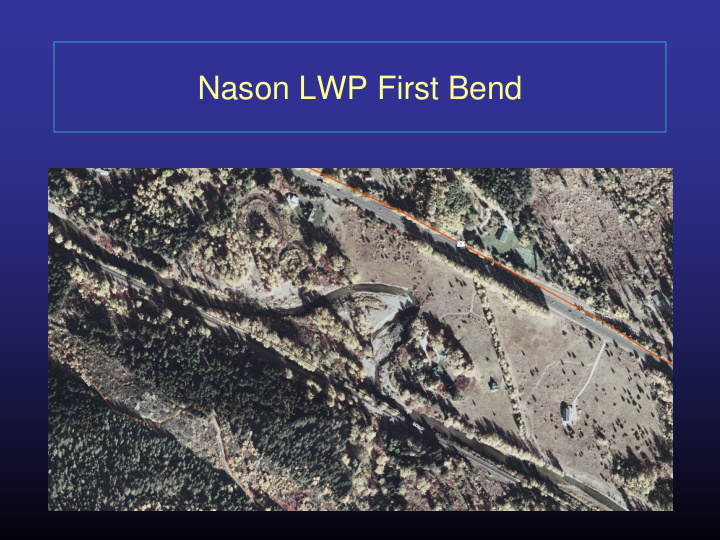



Nason LWP First Bend
Nason LWP First Bend
Nason LWP First Bend Reach geomorphology – Straightening and confinement – Legacy incision – Sediment transport conditions – Riparian vegetation – Accelerated meander scrolling
Nason LWP First Bend Site conditions – Accelerated bank erosion – No woody streambank or riparian vegetation – Low floodplain roughness (in oxbow and on field) – Log jam at downstream end of bend – Poor margin habitat along bank
Nason LWP First Bend Site conditions
Nason LWP First Bend Planform geometry analysis
Nason LWP First Bend Other indicators of imminent avulsion – Headcut along railway embankment
Nason LWP First Bend Other indicators of imminent avulsion – Large bar deposits
Nason LWP First Bend Hydraulic modeling Depth 50-year event
Nason LWP First Bend Existing avulsion risk • Created by human disturbance – Denuded streambank vegetation (root strength) – Denuded floodplain roughness (across oxbow) – Legacy incision – Sediment imbalance • Consequences of avulsion – Additional straightening of reach – Loss of pool-riffle habitat – Probable stranding of existing log jam
No Action Alternative
No Action Alternative Benefits • Low cost and effort • Wait and see approach Risks/Constraints • Does not decrease avulsion risk • Avulsion likely to decrease habitat quantity and quality • Potential abandonment of pool-riffle habitat, and existing log jam, due to avulsion • Uncertain human actions may result from flood damage
Alternative 1 LW and riparian enhancement of existing alignment
Alternative 1 LW and riparian enhancement of existing alignment Benefits • Reduce the human-caused accelerated erosion rate • Limit the likely future increase in avulsion risk • Restore long-term riparian health and LW recruitment • Provide salmonid cover and complexity until riparian recovery Risks/Constraints • Does not decrease avulsion risk • Avulsion likely to decrease habitat quantity and quality • Potential abandonment of project, and log jam, due to avulsion • Nearby private property and infrastructure
Alternative 2 Re-alignment and creation of off-channel habitat
Alternative 2 Re-alignment and creation of off-channel habitat Benefits • Reduce the human-caused accelerated erosion rate • Significantly reduce avulsion risk • Restore long-term riparian health and LW recruitment • Create connected off-channel habitats • Provide salmonid cover and complexity until riparian recovery Risks/Constraints • Nearby private property and infrastructure
Alternative 3 Enhance existing off-channel habitat
Alternative 3 Enhance existing off-channel habitat Benefits • Establish year-round connected off-channel habitat • Add LW cover and complexity to existing off- channel areas • Compatible with other alternatives Risks/Constraints • Areas are connected now except at very low flows • Potential to lower water levels and decrease rearing capacity • Private property and infrastructure • Both channels could potentially be abandoned if an avulsion
Recommend
More recommend